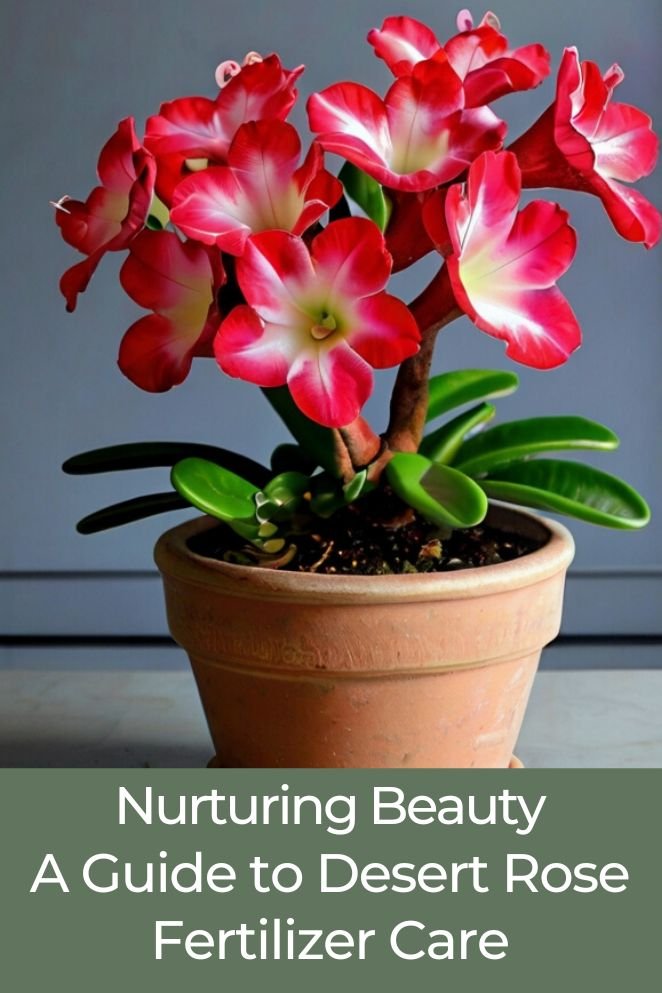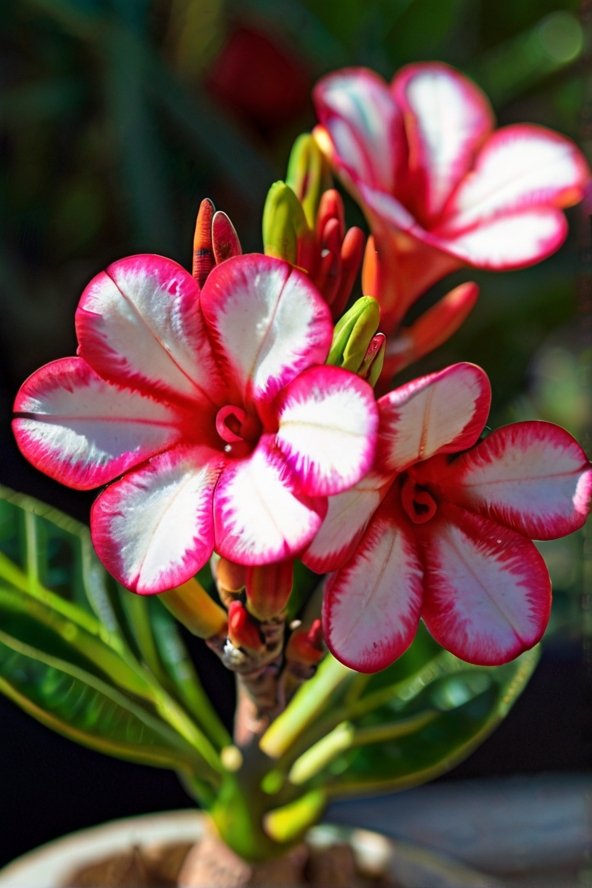
Desert roses, known for their stunning blooms and resilience, require proper care and nutrition to thrive.
Fertilizing desert roses is a crucial aspect of their care routine, but it’s essential to use the right type of fertilizer and apply it correctly.
In this comprehensive guide, we will explore the types of desert rose fertilizers, best practices for application, care tips, and troubleshooting common issues to help you unlock the secrets to successful desert rose care.
Types of Desert Rose Fertilizers
When it comes to choosing the right fertilizer for desert roses, various options cater to their unique nutritional needs.
Understanding the distinct characteristics of each type can guide gardeners in making informed choices for the optimal growth and blooming of these resilient succulents.
- Read also: How to Make Organic Fertilizers at Home
- Read also: How to Lower pH in Soil for a Thriving Garden
Desert rose liquid plant food fertilizer (8oz):
This super-concentrated liquid fertilizer is specifically crafted to enhance flowering and trunk growth in desert roses.
With a well-balanced 3:11:8 ratio, it provides a harmonious blend of macronutrients (nitrogen, phosphorus, potassium) and micronutrients crucial for overall plant health.
Its concentrated formula ensures efficient nutrient absorption, promoting robust blooming and trunk development.
NPK + 9 nutrients desert rose fertilizer/flowering
Formulated for ease of application, high solubility, and rapid root absorption, this fertilizer is designed to fortify desert roses and encourage flowering.
Its balanced nutritional composition supports the strengthening of the plant and facilitates the flowering process.
The inclusion of additional nutrients enhances its effectiveness, contributing to the overall vitality of the desert rose.
Well-balanced, water-soluble, or slow-release fertilizer
Desert roses benefit from well-balanced fertilizers available in water-soluble or slow-release forms.
Fertilizers rich in phosphorus, such as bone meal, prove particularly effective in promoting growth and flowering.
These options offer a convenient and sustained nutrient release, catering to the plant’s needs over an extended period, and ensuring a steady supply of essential NPK nutrients—nitrogen, phosphorus, and potassium.
Balanced liquid fertilizer
Tailored for desert roses, a balanced liquid fertilizer with an elevated phosphorus content serves as an ideal choice for promoting flowering and overall plant health.
This specialized fertilizer provides a gentle push for the plant to bloom, creating an environment conducive to vibrant flower displays and robust overall growth.

Benefits of Using Desert Rose Fertilizer
Desert rose fertilizer provides essential nutrients that help the plant grow and bloom.
Here are some benefits of using desert rose fertilizer:
Promotes growth and blooming
Desert rose fertilizer serves as a vital source of essential nutrients, including nitrogen, phosphorus, and potassium, crucial for promoting robust growth and blooming.
Specifically, phosphorus-rich fertilizers, such as bone meal, prove particularly effective in stimulating and enhancing the blooming process of desert roses.
Balanced nutrition
Formulated with the specific needs of desert roses in mind, these fertilizers provide a well-balanced blend of macronutrients and micronutrients.
This balanced nutrition ensures that the plant receives all the necessary elements in the correct proportions, supporting overall health, resilience, and the development of vibrant blooms.
Convenient and easy application
Designed for user convenience, desert rose fertilizers offer easy application methods, whether water-soluble or slow-release.
Their formulations are crafted to facilitate quick root absorption, ensuring that the essential nutrients reach the plant efficiently and effectively.
Enriches soil
Some desert rose fertilizers, particularly organic options like compost and worm castings, go beyond nourishing the plant.
They contribute to soil enrichment, creating a conducive environment for beneficial organisms such as worms and microbes.
This enrichment enhances the overall soil health, fostering a symbiotic relationship that positively influences the desert rose’s growth.
Prevents over-fertilization
Proper application instructions accompany desert rose fertilizers, helping prevent the risk of over-fertilization.
Over-fertilization can lead to stress-related symptoms such as leaf burn, potentially harming the plant.
The guidance provided ensures that the fertilizer is applied in the right quantities, promoting optimal growth without causing undue stress.

Desert Rose Fertilizer Application
To apply desert rose fertilizer, follow these steps for successful care:
Choose the right fertilizer
Use a slow-release fertilizer, a well-balanced, water-soluble, or slow-release fertilizer, or a fertilizer specifically formulated for succulents.
Phosphorus-rich fertilizers, such as bone meal, can promote growth and flowering.
Timing is key
Fertilize your desert rose during the growing season, from spring to early fall, when the plant is in its growth spurt.
Apply the fertilizer as new growth appears, and continue until early fall.
Reduce or discontinue fertilization in the winter when the plant enters dormancy.
Application method
Apply the fertilizer around the drip line, not at the plant’s base, to ensure that the roots can reach out for nutrients.
Water the plant before and after fertilizing to prevent leaf burn.
Use a balanced liquid fertilizer with a higher phosphorus content to promote flowering and overall plant health.
Protective gear
When handling fertilizers, wear gloves and a mask to protect yourself from chemical exposure.
This is especially important when using synthetic fertilizers.
Pre-fertilizing care
Before fertilizing, ensure that your desert rose is potted in a well-draining soil mix intended for use with cacti and succulents.
During the winter dormancy, apply a diluted fertilizer once a month.
Increase the frequency of fertilization during the plant’s most active growth and blooming stages in spring and summer.

Desert Rose Care Tips
Caring for your desert rose extends beyond fertilization, encompassing several crucial aspects to ensure its overall well-being.
Here are essential care tips for nurturing a healthy and thriving desert rose:
Well-draining soil mix
Pot your desert rose in a well-draining soil mix specifically designed for cacti and succulents.
This promotes optimal water drainage, preventing waterlogged conditions that can lead to root rot.
Proper sunlight exposure
Ensure your desert rose receives adequate sunlight, a fundamental factor for its health.
Place the plant in a location with plenty of sunlight, preferably a spot where it can bask in full sun for a significant part of the day.
This mimics its natural habitat and supports robust growth.
Appropriate watering practices
Adopt a mindful approach to watering your desert rose.
Allow the soil to dry out thoroughly between waterings, preventing excessive moisture that can contribute to root rot and other moisture-related issues.
Strike a balance to keep the soil consistently moist but not overly saturated.
Protection from frost
Shield your desert rose from frost, as these plants are sensitive to cold temperatures.
If you reside in an area prone to frost, consider moving the plant indoors during colder seasons or providing protective coverings to prevent potential damage.
Observant watering schedule
Be observant of your watering schedule and adjust it based on environmental conditions.
During periods of increased heat or dryness, your desert rose may require more frequent watering.
Conversely, in cooler or more humid conditions, it may need less frequent watering.

Troubleshooting Common Issues
Despite your best efforts, you may encounter common issues while caring for your desert rose. These can include issues such as:
here are some common issues related to desert rose fertilization and troubleshooting tips:
Stunted growth
Stunted growth can be caused by insufficient light or over-fertilization.
To address this, increase light exposure and follow fertilizer guidelines.
Adjust your plant care routine as needed to accommodate seasonal changes, temperature fluctuations, or changes in light exposure.
Leaf drop
Leaf drop can be caused by overwatering, underwatering, or sudden changes in temperature.
Ensure proper watering, light management, and pest control.
Evaluate drainage and repot if necessary.
Aim for a Goldilocks zone in terms of temperature—not too hot, not too cold.
Yellowing leaves
Yellowing leaves can be a sign of root rot or overwatering.
Ensure that the plant is potted in a well-draining soil mix intended for use with cacti and succulents.
Allow the soil to dry out between waterings to prevent root rot and other moisture-related issues.
Poor blooming
Poor blooming can be caused by a lack of phosphorus in the soil.
To address this, use a phosphorus-rich fertilizer, such as bone meal, to promote blooming.
Ensure that the plant is receiving adequate sunlight and is not overwatered.
Nutrient burn
Nutrient burns can be caused by over-fertilization.
To address this, reduce or discontinue fertilization and flush the soil with water to help the plant recover.
- Read also: Topsoil vs. Garden Soil: Understanding the Difference
- Read also: A Comprehensive Guide to Growing Cordyline Red Sister Plants
Conclusion
Incorporating fertilizer into your desert rose care routine is a crucial element, but its effectiveness hinges on thoughtful application and integration with other best practices.
Utilizing a fertilizer specifically designed for succulents, applying it accurately, and ensuring optimal growing conditions are essential steps to unlock your desert rose’s full potential.
Armed with the insights and tips outlined in this guide, you’ll be well-prepared to foster stunning blooms and enhance the overall health of your desert rose.
FAQs
It’s best to use a fertilizer specifically formulated for succulents to ensure that your desert rose receives the right balance of nutrients without the risk of over-fertilization.
Fertilize your desert rose during the growing season, which typically spans from spring to summer. Monitor the plant for signs of over-fertilization and adjust the feeding regimen as needed.
Signs of over-fertilization can include leaf burn, poor blooming, and other stress-related symptoms. If you notice these signs, reduce or discontinue fertilization and flush the soil with water to help the plant recover.



